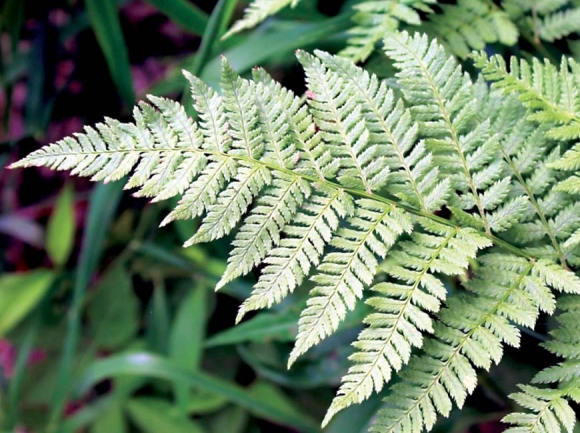Bracken among the world’s most common plants
 Bracken fern.
Bracken fern.
“Here and elsewhere, bracken is such an aggressive plant that one wonders why it has not taken over the world.”
— R.C. Moran, A Natural History of Ferns (2004)
Bracken fern is said to be one of the five most common plants in the world. Standing up to five feet high, it is the coarse leathery fern you have no doubt encountered in disturbed areas, thickets, and dry open woodlands.
The upper leafy portion of the frond (the blade) is broadly triangular in shape. The blade, which is often arranged parallel to the ground, is divided into numerous segments called “pinna” that are further divided into segments called “pinnules,” which can be subdivided again into even smaller segments called “sub-pinnules.”
There are two varieties of bracken (Pteridium aquilinum) in the Smokies region: long-tailed, which has pinna tips up to 15 times as long as broad; and short-tailed, which has pinna tips 4 times as long as broad.
Bracken has its negative aspects. It can be so invasive as to form an almost impenetrable ground cover that shades out less aggressive plant species, many of them showy wildflowers. These dense beds of bracken can persist from rhizomes for hundreds of years.
Related Items
Bracken contains an array of poisons (including hydrogen cyanide) that cause vitamin deficiencies in livestock, “blind staggers” in horses, and death in humans.
Studies have verified that the incidence of stomach cancer increases in countries like England and Japan, where quantities of bracken fiddleheads emerging in spring are harvested. In Japan they are soaked overnight in cold water and then boiled and sautéed with onions, soy sauce and sesame seed oil.
These poisons evolved as defenses against grazing animals and insects that chew, suck and gnaw on the fronds. Bracken attracts more than 100 insect species, including grasshoppers, bees, wasps, beetles, aphids, leafhoppers, bracken borers, and fern moth caterpillars.
And the plant has upped the ante in its never-ending war against its enemies by enlisting the aid of ants. Nectaries situated in the stem joints exude a sugar-like fluid that rewards the ants for discouraging predacious insects. It’s a relationship biologists call mutualism: tit for tat … you help me … I’ll help you.
Not many observers have anything positive to say about bracken. But I do.
Ferns as a plant type have for millions of years explored the possibilities of leaf form and function. Bracken is architecturally one of the most beautifully “designed” plants in the world.
Ever attentive, Thoreau, as usual, summed it up best: “Nature made ferns for pure leaves to show what she could do in that line.”
As Thoreau note, the fronds of bracken are composed of a graceful maze of interrelated segments that are a delight to behold.
(George Ellison is a naturalist and writer. He can be reached at This email address is being protected from spambots. You need JavaScript enabled to view it..)









